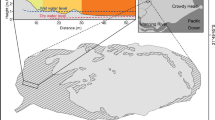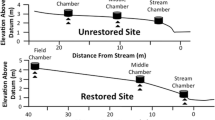Abstract
Tree stem methane emissions are gaining increasing attention as an overlooked atmospheric source pathway. Existing methods for measuring tree stem greenhouse gas fluxes and isotopes may provide robust integrated emission estimates, but due to their coarse resolution, the capacity to derive insights into fine-scale dynamics of tree stem emissions is limited. We demonstrate and field test an alternative method that is Small, Nimble, In situ and allows for Fine-scale Flux (‘SNIFF’) measurements, on complex and contrasting stem surfaces. It is lightweight and therefore suitable to remote field locations enabling real-time data observations allowing for field-based, data driven sampling regimes. This method facilitated novel results capturing fine-scale vertical and radial methane flux measurements (5 cm increments) and revealed: (1) 86–89% of methane emissions emanated from the lower 30 cm of sampled wetland tree species; (2) clear vertical and horizontal trends in δ13C-CH4 possibly due to fractionation associated with oxidation and/or mass-dependant fractionation during diffusive transport; and (3) the occurrence of substantial radial heterogeneity. We also compared a variety of up-scaling approaches to estimate methane flux per tree, including novel smartphone 3D photogrammetry that resulted in substantially higher stem surface area estimations (> 16 to 36%) than traditional empirical methods. Utilising small chambers with high radial and vertical resolution capabilities may therefore facilitate more robust future assessments into the drivers, pathways, oxidation sinks and magnitude of tree stem greenhouse gas emissions, and compliment previous broad-scale sampling techniques.




Similar content being viewed by others
Data Availability
Data used for the composition of this paper can be obtained from https://doi.org/10.17632/x2sf762mhj.1 (Jeffrey 2020).
References
Barba J, Bradford MA, Brewer PE, Bruhn D, Covey K, van Haren J, Pihlatie M. 2019a. Methane emissions from tree stems: a new frontier in the global carbon cycle. New Phytologist 222(1):18–28.
Barba J, Poyatos R, Vargas R. 2019b. Automated measurements of greenhouse gases fluxes from tree stems and soils: magnitudes, patterns and drivers. Scientific Reports 9(1):4005. https://doi.org/10.1038/s41598-019-39663-8.
Bauwens S, Fayolle A, Gourlet-Fleury S, Ndjele LM, Mengal C, Lejeune P, McMahon S. 2017. Terrestrial photogrammetry: a non-destructive method for modelling irregularly shaped tropical tree trunks. Methods in Ecology and Evolution 8(4):460–71. https://doi.org/10.1111/2041-210x.12670.
Carmichael MJ, Bernhardt ES, Bräuer SL, Smith WK. 2014. The role of vegetation in methane flux to the atmosphere: should vegetation be included as a distinct category in the global methane budget? Biogeochemistry 119(1–3):1–24. https://doi.org/10.1007/s10533-014-9974-1.
Chanton J. 1991. Effects of vegetation on methane flux, reservations, and carbon isotopic composition. Trace Gas Emissions from Plants.
Chanton JP, Martens CS, Kelley CA, Crill PM, Showers WJ. 1992a. Methane transport mechanisms and isotopic fractionation in emergent macrophytes of an Alaskan tundra lake. Journal of Geophysical Research: Atmospheres 97(D15):16681–8.
Chanton JP, Whiting GJ, Showers WJ, Crill PM. 1992b. Methane flux from Peltandra virginica: Stable isotope tracing and chamber effects. Global Biogeochemical Cycles 6(1):15–31.
Chauhan R, Ramanathan A, Adhya T. 2008. Assessment of methane and nitrous oxide flux from mangroves along Eastern coast of India. Geofluids 8(4):321–32.
Cignoni P, Callieri M, Corsini M, Dellepiane M, Ganovelli F, Ranzuglia G. 2008. Meshlab: an open-source mesh processing tool. In: Paper presented at the Eurographics Italian chapter conference.
Covey KR, Megonigal JP. 2019. Methane production and emissions in trees and forests. New Phytol 222(1):35–51. https://doi.org/10.1111/nph.15624.
Covey KR, Wood SA, Warren RJ, Lee X, Bradford MA. 2012. Elevated methane concentrations in trees of an upland forest. Geophysical Research Letters . https://doi.org/10.1029/2012gl052361.
Crowther TW, Glick HB, Covey KR, Bettigole C, Maynard DS, Thomas SM, Amatulli G. 2015. Mapping tree density at a global scale. Nature 525(7568):201.
Dean JF, Middelburg JJ, Röckmann T, Aerts R, Blauw LG, Egger M, Dolman AJ. 2018. Methane feedbacks to the global climate system in a warmer world. Reviews of Geophysics . https://doi.org/10.1002/2017rg000559.
Fuss R. 2019. Gasfluxes: greenhouse gas flux calculation from chamber measurements. R package version 0.4-3. https://CRAN.R-project.org/package=gasfluxes.
Fry B. 2006. Stable isotope ecology. New York: Springer. pp 194–270. https://doi.org/10.1007/0-387-33745-8
Gauci V, Gowing DJ, Hornibrook ER, Davis JM, Dise NB. 2010. Woody stem methane emission in mature wetland alder trees. Atmospheric Environment 44(17):2157–60.
Harden HS, Chanton JP. 1994. Locus of methane release and mass-dependent fractionation from two wetland macrophytes. Limnology and Oceanography 39(1):148–54.
Jeffrey LC, Reithmaier G, Sippo JZ, Johnston SG, Tait DR, Harada Y, Maher DT. 2019a. Are methane emissions from mangrove stems a cryptic carbon loss pathway? Insights from a catastrophic forest mortality. New Phytol . https://doi.org/10.1111/nph.15995.
Jeffrey LC, Maher DT, Johnston SG, Kelaher BP, Steven A, Tait DR. 2019b. Wetland methane emissions dominated by plant-mediated fluxes: contrasting emissions pathways and seasons within a shallow freshwater subtropical wetland. Limnology and Oceanography 64:1895–912. https://doi.org/10.1002/lno.11158.
Lavy A, Eyal G, Neal B, Keren R, Loya Y, Ilan M, McMahon S. 2015. A quick, easy and non-intrusive method for underwater volume and surface area evaluation of benthic organisms by 3D computer modelling. Methods in Ecology and Evolution 6(5):521–31. https://doi.org/10.1111/2041-210x.12331.
Liang X, Kankare V, Hyyppä J, Wang Y, Kukko A, Haggrén H, Guan F. 2016. Terrestrial laser scanning in forest inventories. ISPRS Journal of Photogrammetry and Remote Sensing 115:63–77.
Maher DT, Santos IR, Leuven JRFW, Oakes JM, Erler DV, Eyre BD. 2013. “Novel use of cavity ring-down spectroscopy to investigate aquatic carbon cycling from microbial to ecosystem scales. Environmental Science and Technology 47(22):12938–45.
Machacova K, Back J, Vanhatalo A, Halmeenmaki E, Kolari P, Mammarella I, Pihlatie M. 2016. Pinus sylvestris as a missing source of nitrous oxide and methane in boreal forest. Sci Rep 6:23410. https://doi.org/10.1038/srep23410.
Manning FC, Kho LK, Hill TC, Cornulier T, Teh YA. 2019. Carbon emissions from oil palm plantations on peat soil. Frontiers in Forests and Global Change 2:37.
Myhre G, Shindell D, Bréon F-M, Collins W, Fuglestvedt J, Huang J, Mendoza B. 2013. Anthropogenic and natural radiative forcing. Climate Change 423:658–740.
Megonigal JP, Brewer PE, Knee KL. 2019. Radon as a natural tracer of gas transport through trees. New Phytologist.
Miller JB, Tans PP. 2003. Calculating isotopic fractionation from atmospheric measurements at various scales. Tellus B 55(2):207–14.
Nauer PA, Chiri E, de Souza D, Hutley LB, Arndt SK. 2018. Technical note: Rapid image-based field methods improve the quantification of termite mound structures and greenhouse-gas fluxes. Biogeosciences 15(12):3731–42. https://doi.org/10.5194/bg-15-3731-2018.
Neubauer SC, Megonigal JP. 2015. Moving beyond global warming potentials to quantify the climatic role of ecosystems. Ecosystems 18(6):1000–13.
Pangala SR, Enrich-Prast A, Basso LS, Peixoto RB, Bastviken D, Hornibrook ER, Sakuragui CM. 2017. Large emissions from floodplain trees close the Amazon methane budget. Nature 552(7684):230.
Pangala SR, Hornibrook ER, Gowing DJ, Gauci V. 2015. The contribution of trees to ecosystem methane emissions in a temperate forested wetland. Global Change Biology 21(7):2642–54.
Pangala SR, Moore S, Hornibrook ER, Gauci V. 2013. Trees are major conduits for methane egress from tropical forested wetlands. New Phytologist 197(2):524–31.
Pitz S, Megonigal JP. 2017. Temperate forest methane sink diminished by tree emissions. New Phytologist 214(4):1432–9.
Rennenberg H, Schneider S, Weber P. 1996. Analysis of uptake and allocation of nitrogen and sulphur compounds by trees in the field. Journal of Experimental Botany 47(10):1491–8.
Rusch H, Rennenberg H. 1998. Black alder (Alnus glutinosa (L.) Gaertn) trees mediate methane and nitrous oxide emission from the soil to the atmosphere. Plant and Soil 201(1):1–7.
Saunois M, Bousquet P, Poulter B, Peregon A, Ciais P, Canadell JG, Houweling S. 2016. The global methane budget 2000–2012. Earth System Science Data (Online), 8(2).
Siegenthaler A, Welch B, Pangala SR, Peacock M, Gauci V. 2016. Technical note: Semi-rigid chambers for methane gas flux measurements on tree stems. Biogeosciences 13(4):1197–207. https://doi.org/10.5194/bg-13-1197-2016.
Simard SW, Perry DA, Jones MD, Myrold DD, Durall DM, Molina R. 1997. Net transfer of carbon between ectomycorrhizal tree species in the field. Nature 388(6642):579–82.
Sugimoto A, Wada E. 1993. Carbon isotopic composition of bacterial methane in a soil incubation experiment: Contributions of acetate and CO2H2. Geochimica et Cosmochimica Acta 57(16):4015–27.
Sugimoto A, Wada E. 1995. Hydrogen isotopic composition of bacterial methane: CO2/H2 reduction and acetate fermentation. Geochimica et Cosmochimica Acta 59(7):1329–37.
Terazawa K, Ishizuka S, Sakata T, Yamada K, Takahashi M. 2007. Methane emissions from stems of Fraxinus mandshurica var. Japonica trees in a floodplain forest. Soil Biology and Biochemistry 39(10):2689–92.
Teskey RO, Saveyn AS, Steppe K, McGuire MA. 2008. Origin, fate and significance of CO2 in tree stems. New Phytologist 177.
Vann CD, Megonigal JP. 2003. Elevated CO 2 and water depth regulation of methane emissions: comparison of woody and non-woody wetland plant species. Biogeochemistry 63(2):117–34.
Wang ZP, Gu Q, Deng FD, Huang JH, Megonigal JP, Yu Q, Han XG. 2016. Methane emissions from the trunks of living trees on upland soils. New Phytologist 211(2):429–39. https://doi.org/10.1111/nph.13909.
Warner DL, Villarreal S, McWilliams K, Inamdar S, Vargas R. 2017. Carbon dioxide and methane fluxes from tree stems, coarse woody debris, and soils in an upland temperate forest. Ecosystems 20(6):1205–16.
Welch B, Gauci V, Sayer EJ. 2018. Tree stem bases are sources of CH4 and N2 O in a tropical forest on upland soil during the dry to wet season transition. Global Change Biology 25(1):361–72. https://doi.org/10.1111/gcb.14498.
Acknowledgements
This work was supported by funding from the Australian Research Council (LP160100061 and DP180101285). DRT and DTM acknowledge support from the Australian Research Council that partially funds their salaries (DE180100535 and DE150100581, respectively). We thank Dr. Roland Fuß for creating and permission to share the R script, and Bob McDonnell, Roz Hagan and MidCoast Council for fieldwork assistance. We also thank Dr. Patrick Megonigal, one anonymous reviewer and the AE for their constructive comments that helped strengthen the manuscript.
Author information
Authors and Affiliations
Corresponding author
Additional information
Author Contributions
LJ & SJ designed the study; LJ, DM & SJ performed the research; all authors contributed to data analysis and methods development; LJ wrote the first draft and all authors contributed to the final manuscript.
Electronic supplementary material
Below is the link to the electronic supplementary material.
Rights and permissions
About this article
Cite this article
Jeffrey, L.C., Maher, D.T., Tait, D.R. et al. A Small Nimble In Situ Fine-Scale Flux Method for Measuring Tree Stem Greenhouse Gas Emissions and Processes (S.N.I.F.F). Ecosystems 23, 1676–1689 (2020). https://doi.org/10.1007/s10021-020-00496-6
Received:
Accepted:
Published:
Issue Date:
DOI: https://doi.org/10.1007/s10021-020-00496-6




